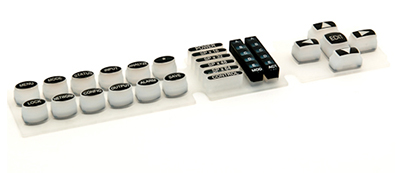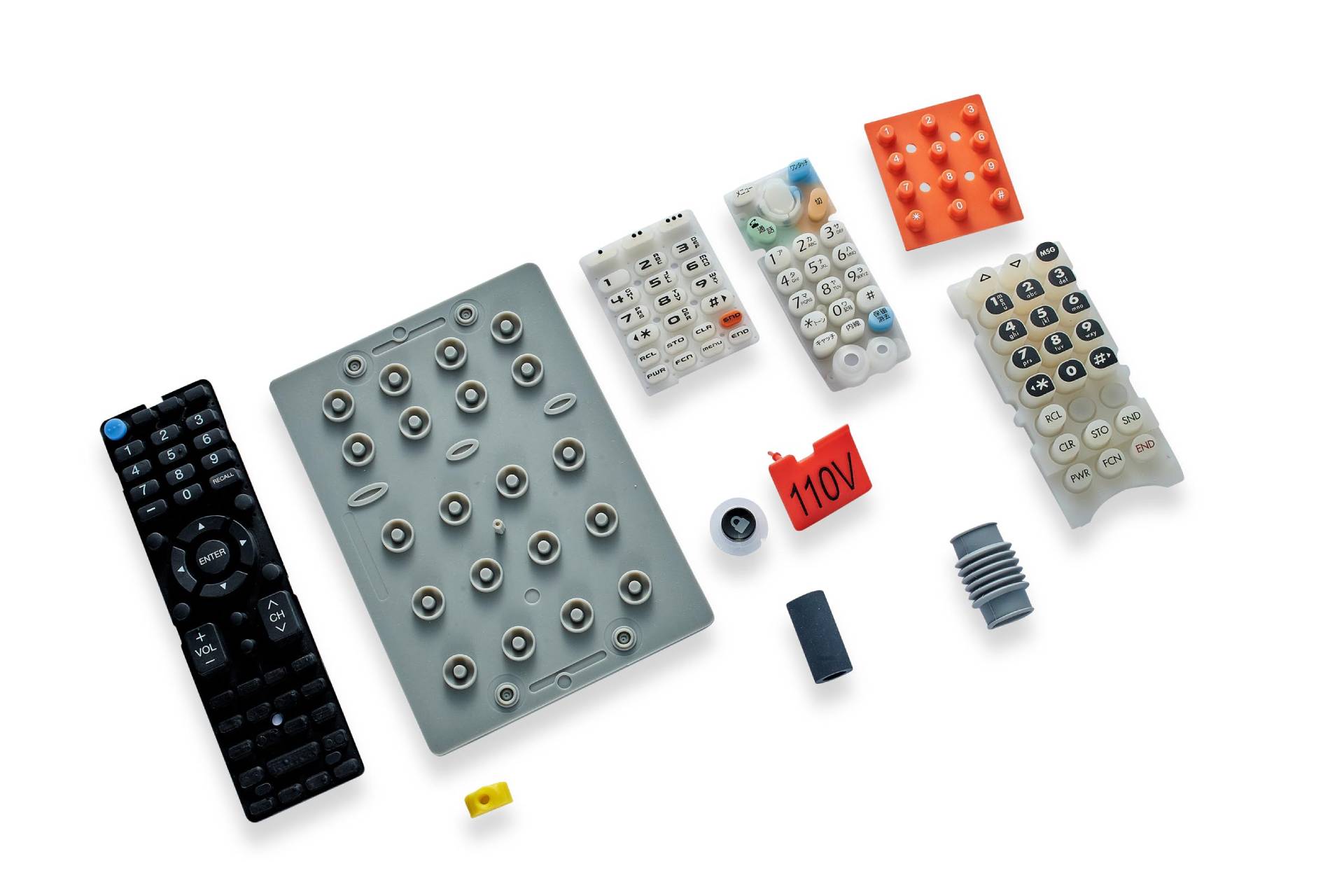Everything engineers should know about designing Rubber Keypads
Uncovering the Diverse Types and utilizes of Rubber Keypads in the Technology Landscape Today
Rubber keypads have actually developed themselves as necessary elements in various technological applications. Their flexibility makes them appropriate for consumer electronics, industrial machines, and medical devices. As these keypads proceed to evolve, brand-new modification choices and style trends arise. This prompts a closer assessment of their benefits and manufacturing procedures. Comprehending these elements may disclose why rubber keypads stay a favored option in the modern technology landscape. What exists ahead for this functional part?
Review of Rubber Keypads
Rubber keypads offer as a basic element in numerous electronic tools, providing a tactile user interface for customer interaction. These keypads are commonly made from silicone or rubber products, which provide versatility and toughness. Their design commonly integrates increased letters or signs, improving use by permitting customers to feel the secrets - Rubber Keypads. Rubber keypads are resistant to dirt, wetness, and use, making them ideal for demanding settings
They can be customized regarding color, size, and form, enabling makers to produce unique user interfaces tailored to certain products. The production procedure commonly includes techniques such as molding and printing, guaranteeing top notch outcome. Because of this, rubber keypads not only boost performance yet additionally contribute to the total visual appeals of the tool. With these characteristics, rubber keypads remain a popular choice for both producers and customers, highlighting their value in the modern technology landscape.
Common Applications in Customer Electronics
While lots of electronic devices rely upon touchscreens for customer interaction, rubber keypads proceed to play an important function in consumer electronic devices. These keypads are extensively used in tools such as remote controls, pc gaming controllers, and household home appliances, where tactile responses improves customer experience. Their longevity and resistance to use make them suitable for gadgets often subjected to hefty use.
Rubber keypads are also popular in portable devices and mobile phones, where small styles necessitate receptive and reputable input techniques. The capacity to personalize the form and structure of rubber keypads enables producers to produce special styles that interest consumers. In addition, the soft touch of rubber provides comfort during long term use, making these keypads a preferred option for gadgets needing extensive interaction. On the whole, rubber keypads stay an essential part in the customer electronics landscape, integrating functionality with easy to use features.
Role in Industrial and Medical Equipment
Rubber keypads play a crucial duty in both industrial and clinical equipment, supplying resilience and dependability in requiring settings. In industrial setups, they are usually made use of in control panels and machinery, boosting operator interaction with complicated systems. Likewise, in the medical area, rubber keypads help with easy to use user interfaces for gadgets that require accuracy and hygiene.
Industrial Tools Applications
Keypads play an essential function in the functionality and user experience of commercial and clinical equipment. In industrial setups, rubber keypads offer a robust user interface for equipment and control systems, enabling operators to quickly input commands and adjust settings. Their resistance to dirt, wetness, and chemicals warranties reliability under rough conditions common of factories and making plants. In addition, the responsive comments offered by rubber keypads boosts customer communication, reducing the possibility of input errors. In addition to traditional equipment, these keypads are essential in automated robotics and systems, where precision is paramount. The flexibility of rubber keypads in numerous commercial applications highlights their relevance in enhancing functional efficiency and guaranteeing safety and security in complicated atmospheres.
Medical Gadget Assimilation
As clinical gadgets significantly call for straightforward interfaces, the integration of rubber keypads has become vital in making certain reliable interaction between medical care specialists and tools. These keypads give tactile comments, helping with user-friendly operation also in high-pressure atmospheres. Their durability and resistance to harsh cleansing agents make them suitable for clinical settings, where health and longevity are vital. Additionally, rubber keypads can be personalized to include numerous forms, sizes, and colors, enhancing aesthetic recognition and access for individuals. This flexibility allows for the creation of specialized controls customized to particular medical features, improving total effectiveness. The duty of rubber keypads in clinical device integration not only enhances capability but additionally promotes person safety and security and functional dependability in health care atmospheres.
Modification Options and Layout Trends
Recent layout fads highlight minimalism and comfort designs, focusing on user comfort and intuitive interaction. Custom-made logo designs and branding can be integrated into keypads, allowing business to preserve a cohesive brand name identity throughout their products. Furthermore, developments in making methods, such as silicone molding, have made it simpler to attain complex layouts and customized layouts.
Advantages of Rubber Keypads Over Various Other Kinds

Rubber keypads are additionally recognized for their resilience and resistance to ecological factors. They can stand up to dampness, dust, and temperature level fluctuations, making them suitable for outside or industrial settings. In addition, rubber keypads are commonly quieter than their plastic or metal equivalents, reducing sound pollution in common settings.
The cost-effectiveness of rubber keypads makes them an eye-catching alternative for producers. Their light-weight nature look at here adds to decrease delivery costs, while their personalized styles deal with particular branding needs. In general, rubber keypads represent a trustworthy and flexible remedy in the modern technology landscape.
Manufacturing Techniques for Top Quality and Toughness
In the production of rubber keypads, the option of proper materials and molding processes plays a vital role in establishing general top quality and longevity. Numerous molding methods, such as compression and injection molding, considerably affect the end product's performance. Comprehending these aspects is vital for attaining perfect cause rubber keypad production.
Molding Processes Discussed
A selection of molding procedures play an important function in the production of rubber keypads, making sure both high quality and longevity. One of the most common strategies include compression molding, transfer molding, and shot molding. Compression molding includes putting rubber in a heated mold and mildew, where warmth and pressure shape it into the wanted kind. Transfer molding allows for more precise control over material flow and appropriates for complicated styles (Rubber Keypads). Injection molding, recognized for its speed and effectiveness, infuses molten rubber into a mold and mildew under high stress, producing high-volume parts with regular quality. Each technique uses distinct advantages, affecting factors such as manufacturing price, style, and speed flexibility, inevitably affecting the performance and life expectancy of rubber keypads in various applications
Product Selection Value
Material selection plays a vital duty in the manufacturing of rubber keypads, directly affecting their efficiency and durability. The choice of rubber substances, such as silicone or polyurethane, influences responsive comments, resistance to wear, and environmental toughness. High-grade products guarantee that keypads can endure considerable usage, preserving their performance in time. In addition, the solution of rubber impacts its resistance to temperature level changes and direct exposure to chemicals, which are critical for gadgets in different settings. Employing sophisticated production methods, such as compression or injection molding, additional boosts the architectural integrity of keypads. Ultimately, mindful product option and manufacturing procedures add greatly to the general high quality, long life, and customer fulfillment of rubber keypads in today's innovation landscape.
Future Fads in Rubber Keypad Modern Technology
As technology continues to advance, the future of rubber keypad development appears encouraging, with innovations positioned to boost capability and individual experience. One noteworthy pattern is the assimilation of touch-sensitive innovation, enabling capacitive responses that mimics the feeling of conventional buttons while supplying improved responsiveness. Furthermore, the growth of antimicrobial materials is likely to obtain traction, attending to health problems in public and common tools.
Moreover, customization options are expected to broaden, permitting individuals to individualize key formats and tactile comments, therefore catering to varied demands. The unification of clever technology, such as connectivity attributes, might additionally arise, allowing rubber keypads to engage with various other tools effortlessly. As manufacturers concentrate on sustainability, environment-friendly materials are prepared for to become more widespread, aligning with international environmental goals. On the whole, these trends promise to transform rubber keypads, making them extra functional, easy to use, and environmentally mindful in the innovation landscape.
Often Asked Concerns
How Do Rubber Keypads Compare in Price to Other Keypad Types?
Rubber keypads usually offer an economical option compared to other keypad types, such as membrane layer or mechanical options. Their reduced production costs and durability make them an attractive selection for different applications in technology.
What Are the Ecological Influences of Rubber Keypad Manufacturing?

The environmental influences of rubber keypad production consist of resource deficiency, power intake, and contamination from producing processes. Furthermore, improper disposal can lead to plastic waste, contributing to ecological destruction and hurting communities if not taken care of responsibly.
Can Rubber Keypads Be Utilized Outdoors?
Rubber keypads can be made use of outdoors due to their durability and resistance to weather elements. Their long life might depend on the top quality of products used and the specific environmental conditions they are revealed to.
What Maintenance Is Required for Rubber Keypads?
Rubber keypads call for routine cleaning to remove dirt and debris, periodic assessment for deterioration, and protection from severe temperatures. Guaranteeing correct storage problems can expand their life-span and preserve capability gradually.
How Do Rubber Keypads Perform in Extreme Temperatures?
Rubber keypads generally keep capability in extreme temperatures, exhibiting durability to both cold and heat. However, extended exposure go to the website might cause material degradation, impacting their responsive action and total performance in rough environments.
Rubber keypads offer as a basic element in numerous electronic gadgets, providing a tactile interface for user interaction. While many electronic devices count on touchscreens for individual interaction, rubber keypads continue to play an important role in consumer electronics. Furthermore, the soft touch of rubber provides convenience during long term usage, making these keypads a recommended option for devices calling for extended communication. In spite of the growing range of keypad materials available, rubber keypads offer unique benefits that make them a favored option in lots of applications. Rubber keypads usually check over here provide a cost-effective solution contrasted to other keypad kinds, such as membrane layer or mechanical choices.